Publication
Article
Pharmacy Times
OTC Drugs and the Pediatric Patient
Author(s):
Concerns about overdosing and medication errors in children have led to new guidelines from the FDA.
Concerns about overdosing and medication errors in children have led to new guidelines from the FDA.
The safe use of nonprescription drugs is important for all patients. Certain patient populations, including pediatric patients, the elderly, women who are pregnant or lactating, those with certain medical conditions, and those currently taking prescription drugs, may be considered more vulnerable to experiencing potential drug therapy problems, adverse drug reactions, and contraindications when compared with the average healthy individual.1,2
This article will focus on the efforts being made to provide safe and effective use of nonprescription drugs to the pediatric patient population. In response to reports of unintentional drug overdoses and administration errors with OTC liquid medications given to pediatric patients, the FDA released new voluntary industry guidelines in November 2009 that recommend greater consistency and clarification of OTC medication dosing directions and their accompanying measuring devices.3,4 The FDA guidelines include the following recommendations3,4:
1. All OTC liquid medications should be packaged with a measuring device.
2. Abbreviations and units of measure used on measuring devices should be the same as those listed in the product’s directions.
3. Devices should have only necessary markings and should not hold significantly more than the largest dose listed on the label.
4. Abbreviations should be clearly defined and should conform to international or national standards.
5. Caution should be exercised when using decimals and fractions. Their use should conform to recommendations of using leading zeros before decimal points to avoid 10-fold dosing errors, and smaller fonts to express fractions to differentiate between fractions and whole numbers.
6. Patients should be encouraged to use measuring devices, and studies should be conducted to evaluate and confirm accurate use of liquid OTC products by patients.3
More information about the 2009 FDA recommendations can be found at www. fda.gov/downloads/Drugs/Guidance ComplianceRegulatory Information/ Guidances/UCM188992.pdf.
Because pharmacists are considered among the most accessible health care professionals, they play an instrumental role in ensuring that parents and caregivers correctly select and administer nonprescription products to pediatric patients. Among children, the top-selling pediatric OTC products include analgesics/ antipyretics and cough/cold, allergy, and gastrointestinal (GI) medications.3 In the United States, an estimated $3.5 billion is spent annually on cough/cold medications alone.5
Results from a study regarding the prevalence of nonprescription drug use among 3-year-old patients reported that 53.7% of those studied had received an OTC medication within the preceding 3 months.2 The most common OTC medications administered to subjects were acetaminophen and cough/cold products.2
An estimated 4 million children younger than 12 years are treated with OTC cough and cold products each week in the United States.5 More than 50% of children in the United States are given some type of nonprescription medication weekly.3
Differences in physiology and pharmacokinetics, lack of sufficient clinical data within this patient population, insufficient drug labeling, and problems related to proper dosage and administration pose challenges to providing pharmaceutical care to pediatric patients.2 Examples of potential problems that may arise when considering drug therapy among children include unnecessary drug use, inaccurate dosing, and improper administration and dosage form.2
Studies have reported that 40% to 60% of parents/caregivers make errors when administering medications to their children. 3 Concerns about the safety and efficacy of OTC cough/cold medications have led to a recent FDA public health advisory against using these agents in children younger than 2 years unless given specific directions to do so by a physician.6,7
Several studies have been conducted to evaluate the safety and efficacy of nonprescription drug use in the pediatric patient population. In 1 study published in the June 2009 issue of Pediatrics, the goal was to evaluate the caregiver’s understanding of the age indication on OTC cold medication labels and identify factors associated with the caregiver’s level of understanding. 6
The study included 182 parents/caregivers, 87% of whom were mothers of infants. After the subjects reviewed the labels of these products, 86% of the time they thought that they were appropriate to use in children younger than 2 years. In addition, more than 50% of the parents stated that they would administer these products to a 13-month-old child who had cold

symptoms.
The study authors found that caregivers with lower numeracy skills were more likely to provide inappropriate reasons for giving an OTC medication. They concluded that the misunderstanding of OTC cold products is very prevalent and could result in medical errors if these agents are given inappropriately.6 The study also concluded that there are many opportunities for both the FDA and product manufacturers to modify product labels to improve consumer understanding of these products, thus enhancing patient safety.6
Results from another study, published in the December 15, 2010, issue of The Journal of the American Medical Association, evaluated the prevalence of inconsistent dosing directions and measuring devices among the most commonly used pediatric OTC liquid medications at the time the FDA’s 2009 guidelines were released.3 The study evaluated 200 of the top-selling pediatric liquid preparations of OTC products, which included analgesics/antipyretics, and cough/cold, allergy, and GI medications intended for those younger than 12 years.3 The study revealed that more than 25% of the products did not contain a measuring device for administration. Among those products that contained a measuring device, 98.6% of the measuring devices had markings that were inconsistent with the product’s dosing directions and 81.1% had unnecessary markings.3 In addition, 24.3% of the included measuring devices were missing necessary unit markings. 3 Furthermore, 5.5% of the products studied contained nonstandard units of measurement, such as drams, cubic centimeters, or fluid ounces, which could lead to confusion in dosing and result in errors.3
The study concluded that at the time the FDA issued its voluntary guidance, the majority of nonprescription liquid medications contained dosing directions and measuring devices that were significantly variable and inconsistent.3 Hopefully the 2009 FDA guidelines will prompt all manufacturers to provide consumers with standard measuring devices for liquid OTC drugs as well as consistent and easy to- follow administration directions that will decrease the potential for medication errors.
The American Academy of Pediatrics recommends that medications be dosed in milliliters instead of teaspoons or tablespoons to avoid confusion or incorrect dosing. Sometimes the abbreviations for teaspoons and tablespoons are confused, which can lead to under- or overdosing. Dosing that is expressed in decimal form should always include a leading zero before the decimal point to avoid overdosing.
Through proper patient education and the use of a standardized measuring device, the accuracy of dosing liquid OTC products may be enhanced and the incidence of dosing errors lessened. Patients should be advised to always use a calibrated measuring device to ensure accuracy and to never use a household spoon, because they do not come in uniform sizes and their use may lead to a significant dosing error. Parents should be reminded to always consult their primary health care provider when in doubt about dosing and the appropriateness of using an OTC agent, and to always read the product label prior to administering any drug to a child.
Prior to recommending any products, pharmacists should always screen for potential drug—drug interactions and contraindications. When counseling patients about nonprescription pediatric products, pharmacists should always ensure that the parent and/or caregiver clearly understands both the dosing and administration instructions and provide them with nonpharmacologic measures that may help with various ailments. The National Council on Patient Information and Education Web site and the FDA Web site both provide a series of tips that parents/caregivers can use when selecting and using OTC drugs for children (see sidebar).8,9
Ms. Terrie is a clinical pharmacy writer based in Haymarket, Virginia.
References
1. Precautions with over-the counter drugs. Merck Manual Online Edition. www.merckmanuals.com/home/sec02/ch018/ch018b.html. Accessed January 2, 2011.
2. Lawrence B, Isetts B. Patient assessment and consultation. In: Berardi R, Newton G, McDermott JH, et al, eds. Handbook of Nonprescription Drugs. 16th ed. Washington, DC: American Pharmacists Association; 2009:26-29.
3. Yin HS, Wolf MS, Dreyer BP, Sanders LM, Parker RM. Evaluation of consistency in dosing directions and measuring devices for pediatric nonprescription liquid medications. JAMA. 2010;304(23):2595-2602.
4. Dosage delivery devices for OTC liquid drug products. Food and Drug Administration Web site. www.fda.gov/downloads/Drugs/GuidanceComplianceRegulatoryInformation/Guidances/UCM188992.pdf. Accessed January 3, 2011.
5. Dart RC, Paul IM, Bond GR, et al. Pediatric fatalities associated with over the counter (nonprescription) cough and cold medications. Ann Emerg Med. 2009;53(4):411-417.
6. Lokker N, Sanders L, Perrin EM, et al. Parental misinterpretations of over-the-counter pediatric cough and cold medication labels. Pediatrics. 2009;123(6):1464-1471.
7. Public health advisory: nonprescription cough and cold medicine use in children. Food and Drug Administration Web site. www.fda.gov/Drugs/DrugSafety/PostmarketDrugSafetyInformationforPatientsandProviders/DrugSafetyInformationforHeathcareProfessionals/PublicHealthAdvisories/ucm051282.htm. Accessed January 3, 2011.
8. Ten tips for parents. BeMedWise Web site. www.bemedwise.org/ten_ways/top_tips_parents.htm. Accessed January 3, 2010.
9. Giving medication to children. Food and Drug Administration Web site. www.fda.gov/ForConsumers/ConsumerUpdates/ucm164427.htm. Accessed January 4, 2011.

Newsletter
Stay informed on drug updates, treatment guidelines, and pharmacy practice trends—subscribe to Pharmacy Times for weekly clinical insights.






